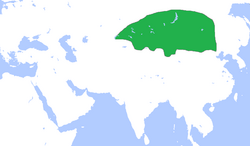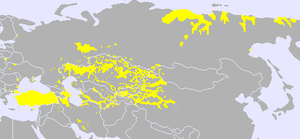شوىيانتوو
| جزء من سلسلة عن | ||||||||||||||
| تاريخ منغوليا | ||||||||||||||
|---|---|---|---|---|---|---|---|---|---|---|---|---|---|---|
 | ||||||||||||||
| الفترة القديمة | ||||||||||||||
|
||||||||||||||
| العصور الوسطى | ||||||||||||||
|
||||||||||||||
| الفترة المعاصرة | ||||||||||||||
|
||||||||||||||
| موضوعات | ||||||||||||||
شوىيانتوو (薛延陀 ؛ Xueyantuo) (Seyanto, Se-yanto, Se-Yanto) or Syr-Tardush were an ancient Tiele Turkic people and Turkic khanate in central/northern Asia who were at one point vassals of the Gokturks, later aligning with China's Tang Dynasty against the Eastern Gokturks. The Xueyanto homeland is near the Selenga River/Xueyanhe River (薛延河江/偰輦河江), so their tribe's name is Seyanto/Xueyantuo (薛延陀), Chinese Han characters underwent considerable changes according to changes in Chinese dynasties, so the tribe is variously known as Xueyantuo, Xueyanhe, Xienianhe, Seyanto, Selenga, Selyanha, etc.
. . . . . . . . . . . . . . . . . . . . . . . . . . . . . . . . . . . . . . . . . . . . . . . . . . . . . . . . . . . . . . . . . . . . . . . . . . . . . . . . . . . . . . . . . . . . . . . . . . . . . . . . . . . . . . . . . . . . . . . . . . . . . . . . . . . . . . . . . . . . . . . . . . . . . . . . . . . . . . . . . . . . . . . .
التاريخ
Initially the Xue and the Yantuo were two separate tribes. The Xue appeared earlier as Xinli but were not referred to again until the 7th century.[4][5] After Yishibo, the Xueyantuo founded a short-lived Qaghanate over the steppe under Zhenzhu Khan, his son Duomi Khan and nephew Yitewushi Khan, the last of which eventually surrendered to the Chinese.
في 27 مارس 630، تحالفت شوىيانتوو مع الصينيين لهزيمة الخاقانية الشرقية في جبال ين. Illig Qaghan escaped, but was handed over to the Chinese by his subordinate qaghan on May 2.[6][7]
انظر أيضاً
- قائمة الأسر والبلدان التوركية
- Timeline of Turks (500-1300)
- شوى
- Selenga River
- تانگ اللاحقة
- Sir-Kıvchak
المراجع
الهامش
- ^ Marshall Cavendish Corporation (2006). Peoples of Western Asia. p. 364.
{{cite book}}: External link in|ref= - ^ Bosworth, Clifford Edmund (2007). Historic Cities of the Islamic World. p. 280.
{{cite book}}: External link in|ref= - ^ Borrero, Mauricio (2009). Russia: A Reference Guide from the Renaissance to the Present. p. 162.
{{cite book}}: External link in|ref= - ^ Pulleyblank, "Central Asia and Non-Chinese Peoples of Ancient China", p. VII 21-26.
- ^ Duan, "Dingling, Gaoju and Tiele", p. 370.
- ^ Duan, "Dingling, Gaoju and Tiele", p. 362, 388-389, 430.
- ^ Bo Yang, "Zizhi Tongjian", p. 11,651-11,654 (Vol.46).
المصادر
- Bo Yang. Modern Chinese Edition of Zizhi Tongjian (Vol. 45). Taipei: Yuan-Liou Publishing Co. Ltd ISBN 957-32-0868-7.
- Duan Lianqin (1988a). Xueyantuo During the Period of Sui and Tang. Xi'an: Sanqin Press. ISBN 7-80546-024-8.
- Duan Lianqin (1988b). Dingling, Gaoju and Tiele. Shanghai: Shanghai People's Press. ISBN 7-208-00110-3.
- New Book of Tang, vol. 217, part 3 [1].
- Zizhi Tongjian, vols. 192, 193, 194, 195, 196, 197, 198, 199.
- Zuev Yu.A. "Kaganate Seyanto and Kimeks. (To Turkic ethnogeography of Central Asia in the middle of 7th c.)", Shygys, 2004, No 1 pp 11–21, No 2 pp 3–26
- Zuev Yu.A., "Horse Tamgas from Vassal Princedoms (Translation of Chinese composition "Tanghuyao" of 8-10th centuries)", Kazakh SSR Academy of Sciences, Alma-Ata, I960, (In Russian)
- Articles with hatnote templates targeting a nonexistent page
- Portal-inline template with redlinked portals
- Pages with empty portal template
- شوىيانتوو
- شعوب توركية في آسيا
- الشعوب القديمة في الصين
- القرن السابع في الصين
- شعوب قديمة في روسيا
- جماعات بدوية في أوراسيا
- تاريخ منغوليا
- دول توركية تاريخية
- أسرة تانگ
- بلدان سابقة في التاريخ الصيني
- تأسيسات القرن السابع في الصين
- انحلالات 646
- انحلالات القرن السابع في الصين
- گوقتورك


